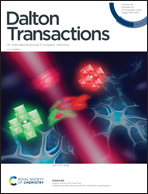Substituent-regulated mechanism on reaction Cp2NbH3 (Cp = η5-C5H5) with RC![[triple bond, length as m-dash]](https://www.rsc.org/images/entities/char_e002.gif) CR (R = COOMe and Me)†
CR (R = COOMe and Me)†
Abstract
The reaction of alkynes with bis-cyclopentadienyl hydride complexes of niobium has aroused substantial concern due to their important roles in catalytic hydrogenation processes. In this paper, the reaction mechanisms of Cp2NbH3 (Cp = η5-C5H5) with substituted alkynes RC![[triple bond, length as m-dash]](https://www.rsc.org/images/entities/char_e002.gif) CR (R = COOMe (1) and Me (2)) were investigated and compared based on density functional theory (DFT) calculations. The calculated results demonstrate that the reaction mechanisms and products of the title reactions are regulated by the characteristics of the alkyne substituent. For alkynes that feature the electron-withdrawing substituent COOMe, the corresponding fumaric ester complex, namely, Cp2NbH(trans-MeO2CCH
CR (R = COOMe (1) and Me (2)) were investigated and compared based on density functional theory (DFT) calculations. The calculated results demonstrate that the reaction mechanisms and products of the title reactions are regulated by the characteristics of the alkyne substituent. For alkynes that feature the electron-withdrawing substituent COOMe, the corresponding fumaric ester complex, namely, Cp2NbH(trans-MeO2CCH![[double bond, length as m-dash]](https://www.rsc.org/images/entities/char_e001.gif) CHCO2Me), can be obtained at ambient temperature through an insertion process. For alkynes that feature the electron-donating substituent Me, the products are hydride niobocene Cp2NbH(MeC
CHCO2Me), can be obtained at ambient temperature through an insertion process. For alkynes that feature the electron-donating substituent Me, the products are hydride niobocene Cp2NbH(MeC![[triple bond, length as m-dash]](https://www.rsc.org/images/entities/char_e002.gif) CMe) and H2, which are obtained via the elimination of hydrogen molecules, and they can only be obtained with irradiation by UV light. Our studies provide reasonable explanations for experimental observations and predict new chemical reactions in this domain.
CMe) and H2, which are obtained via the elimination of hydrogen molecules, and they can only be obtained with irradiation by UV light. Our studies provide reasonable explanations for experimental observations and predict new chemical reactions in this domain.
![Graphical abstract: Substituent-regulated mechanism on reaction Cp2NbH3 (Cp = η5-C5H5) with RC [[triple bond, length as m-dash]] CR (R = COOMe and Me)](/en/Image/Get?imageInfo.ImageType=GA&imageInfo.ImageIdentifier.ManuscriptID=D0DT03033C&imageInfo.ImageIdentifier.Year=2020)


 Please wait while we load your content...
Please wait while we load your content...
![[triple bond, length as m-dash]](https://www.rsc.org/images/entities/h2_char_e002.gif) CR (R = COOMe and Me)
CR (R = COOMe and Me)